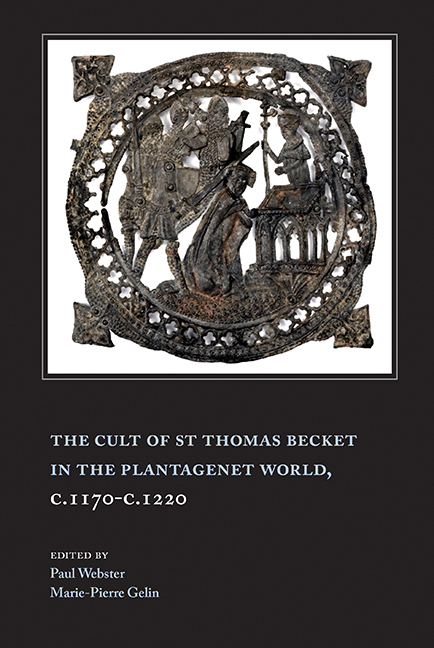Book contents
- Frontmatter
- Contents
- List of Illustrations
- List of Contributors
- Preface
- Acknowledgements
- List of Abbreviations
- 1 Introduction. The Cult of St Thomas Becket: An Historiographical Pilgrimage
- 2 Becket is Dead! Long Live St Thomas
- 3 The Cult of St Thomas in the Liturgy and Iconography of Christ Church, Canterbury
- 4 Thomas Becket and Leprosy in Normandy
- 5 Thomas Becket in the Chronicles
- 6 Matilda, Duchess of Saxony (1168–89) and the Cult of Thomas Becket: A Legacy of Appropriation
- 7 Leonor Plantagenet and the Cult of Thomas Becket in Castile
- 8 Crown Versus Church After Becket: King John, St Thomas and the Interdict
- 9 The St Thomas Becket Windows at Angers and Coutances: Devotion, Subversion and the Scottish Connection
- Bibliography
- Index
1 - Introduction. The Cult of St Thomas Becket: An Historiographical Pilgrimage
Published online by Cambridge University Press: 25 October 2017
- Frontmatter
- Contents
- List of Illustrations
- List of Contributors
- Preface
- Acknowledgements
- List of Abbreviations
- 1 Introduction. The Cult of St Thomas Becket: An Historiographical Pilgrimage
- 2 Becket is Dead! Long Live St Thomas
- 3 The Cult of St Thomas in the Liturgy and Iconography of Christ Church, Canterbury
- 4 Thomas Becket and Leprosy in Normandy
- 5 Thomas Becket in the Chronicles
- 6 Matilda, Duchess of Saxony (1168–89) and the Cult of Thomas Becket: A Legacy of Appropriation
- 7 Leonor Plantagenet and the Cult of Thomas Becket in Castile
- 8 Crown Versus Church After Becket: King John, St Thomas and the Interdict
- 9 The St Thomas Becket Windows at Angers and Coutances: Devotion, Subversion and the Scottish Connection
- Bibliography
- Index
Summary
On 29 December 1170, Thomas Becket, archbishop of Canterbury, was murdered in his own cathedral by four knights who apparently believed they were acting on the wishes of King Henry II. A controversial figure in life, news of the circumstances of Becket's death sent shockwaves through England, the Plantagenet world and medieval Europe as a whole. In 1173, the London merchant's son, whose meteoric rise had taken him through the household of Archbishop Theobald to the chancellorship of England and on to the archbishopric and well-documented stand-off with the king, was officially recognised as a saint. By the end of 1174, Henry II had twice performed public penance for his part in what was popularly deemed to be martyrdom. In 1220, the relics were moved to a magnificent shrine in the Trinity Chapel, where they remained until the sixteenth century. Today, a candle still marks the site once occupied by one of the foremost shrines in Western Christendom, one that rivalled Rome and Compostela as the centre of one of the most popular cults of the medieval Church.
Historians of Thomas Becket have naturally focused on the crisis in relations between crown and Church in which he was so prominent. His twentieth- and early twenty-first-century biographers tended to devote some attention to the aftermath of the murder, focusing for example on the swift occurrence of miracles and the way in which this turned his burial place into a centre of pilgrimage. ‘Canterbury became almost overnight the Lourdes of its world’, although the events that had taken place within the cathedral meant that the church itself was in effect closed for almost a year after Becket's death. By popular demand, however, from Easter 1171 visitors were allowed to see the tomb, at which point the monks Benedict, and later William, were delegated to record details of cures reported there. All this suggests that the emergence of the cult was a popular rather than a monk-led movement in its first days and weeks. The biographies go on to outline the reaction of Henry II, the papal response, the penances imposed on the murderers, the settlement at Avranches and its confirmation at Caen in 1172, the canonisation in 1173, the Great Rebellion (1173–74) and the king's penitential pilgrimage to Canterbury in 1174.
- Type
- Chapter
- Information
- Publisher: Boydell & BrewerPrint publication year: 2016



